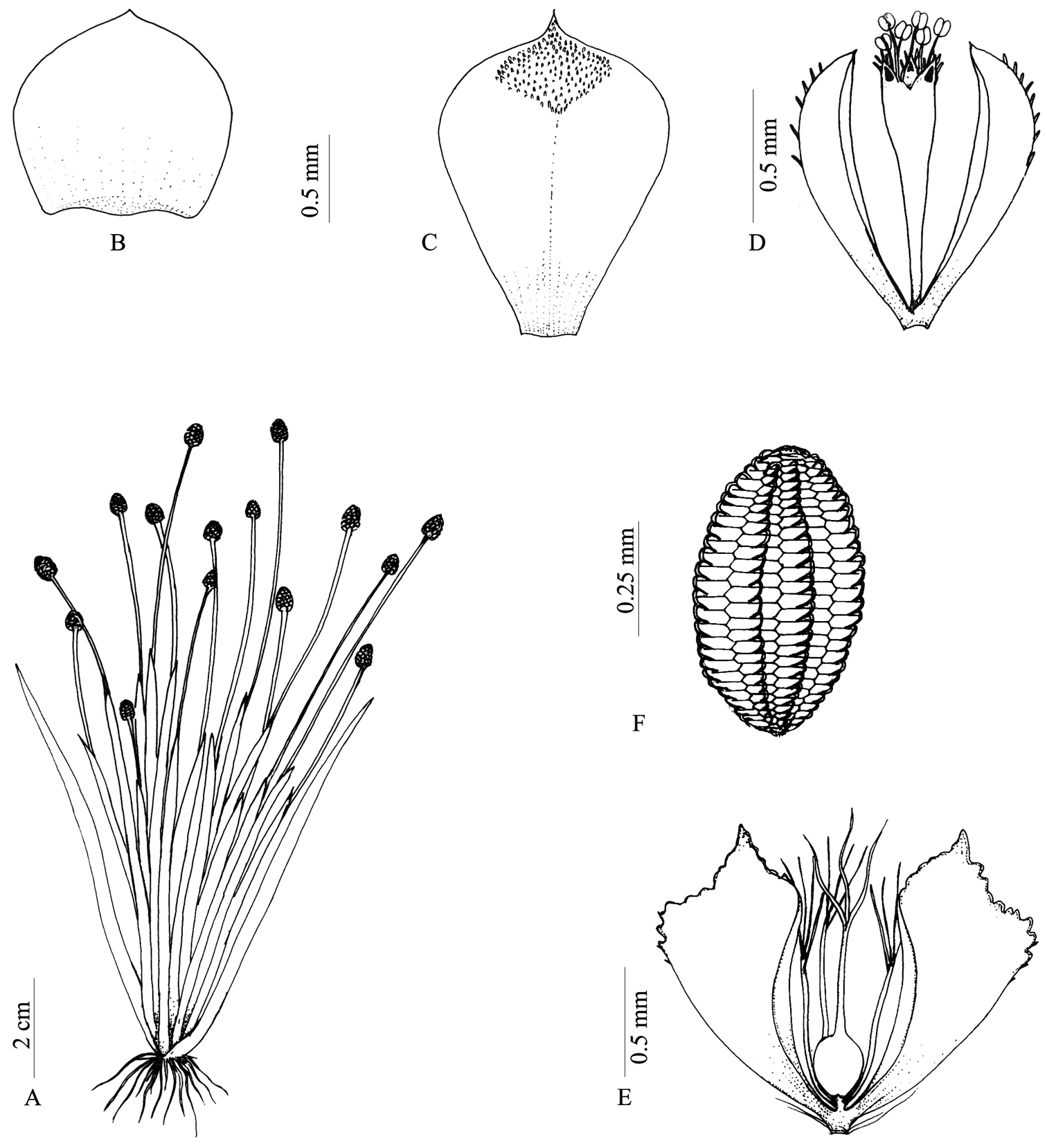






(C) 2012 M. M. Swapna. This is an open access article distributed under the terms of the Creative Commons Attribution License 3.0 (CC-BY), which permits unrestricted use, distribution, and reproduction in any medium, provided the original author and source are credited.
For reference, use of the paginated PDF or printed version of this article is recommended.
Eriocaulon madayiparense Swapna, Rajesh, Manju & Prakashkumar, sp. nov. is described and illustrated from the Madayipara, a lateritic hillock in the midland of Kannur District of Kerala. The species is allied to Eriocaulon eurypeplon Koernicke, in its two free male and female sepals, female sepals being keeled and acute and not exceeding the floral bracts, acuminate leaf apex and setiform seed appendages appearing in vertical rows, but differs mainly in having yellow seeds with solitary appendage arising from transverse radial walls, curved and connate with the adjacent ones of the same vertical row forming longitudinal parallel ribs on the surface of the seeds.
Eriocaulon madayiparense, Eriocaulaceae, India, Western Ghats, Madayipara, Laterite hill
The genus Eriocaulon is well represented in India with many endemic species.
Comparison between Eriocaulon eurypeplon and Eriocaulon madayiparense
| Characters | Eriocaulon eurypeplon | Eriocaulon madayiparense |
|---|---|---|
| Involucral bract | Obtuse-subacute, minutely hoary dorsally, straw coloured | acute-acuminate, glabrous, black |
| Female flower | Pedicels glabrous | Pedicels hairy |
| Sepals | obovate, acute or obtuse, entire | oblance-ovate or oblanceolate, irregularly toothed towards apex at back |
| Petals | equal | subequal |
| Seeds | dark purple, appendages 1-2 from transverse radial walls, free, setiform, dilated at apex | Yellow, appendages solitary from transverse radial walls, curved and connate with the adjacent ones of the same vertical row forming longitudinal parallel ribs on the surface of seeds |
Eriocaulon madayiparense is allied to Eriocaulon eurypeplon Koernicke, but differs mainly in having black, glabrous, acute-acuminate involucral bracts, pedicels of female flowers hairy at base, female sepals oblance-ovate or oblaceolate, cuneate, conduplicate, keeled, irregularly toothed towards apex, yellow seeds with solitary appendage arising from transverse radial walls, curved and connate with the adjacent ones of the same vertical row forming longitudinal parallel ribs on the surface of seeds.
INDIA. Kerala, Kannur District, Madayipara, 40 m alt., 5 September 2011, K.P.Rajesh & C.N.Manju 5610 (Holotype: MBGS! Isotypes: MBGS!, MH!, CALI!, K!)
Acaulescent herbs. Root stock absent. Leaves linear-lanceolate, acute or acuminate, ca. 10–12 × 0.5–0.7 cm, glabrous. Peduncles erect, 2- many, ca. 7–13 cm long, rigid, glabrous. Sheaths ca. 5–7 cm long, glabrous; limb ovate, acuminate, entire. Heads globose-ovate, ca. 8 × 6 mm, grey. Receptacle cylindrical, sparsely pilose. Involucral bracts erect, ovate or obovate, acute-acuminate, ca. 1.1 × 1.2 mm, chartaceous, black. Floral bracts closely imbricated, obovate, base cuneate, apex acuminate, ca. 1.8 × 1.3 mm, coriaceous, minutely hoary dorsally towards apex, black. Male flowers: Pedicels minute. Sepals 2, free, oblanceolate, obtuse or acute, keeled, ca. 1.2 mm long, minutely hoary along keels towards apex, black. Stipe of corolla ca. 0.9 mm long. Petals 3, equal, minute, oblong, minutely hoary and minutely toothed at apex with a black gland, anthers 6, black. Female flowers: Pedicels minute, hairy at base. Sepals 2, free, similar, oblanceolate-ovate or oblanceolate, cuneate, conduplicate, keeled, irregularly toothed towards apexon keel, ca. 1.5 mm long, minutely hoary along keels towards apex, black. Petals 3, linear, subequal, ca. 0.6 to 0.8 mm long, hyaline, barbate towards apex, with or without a black gland, not stipitate between sepals and petals. Ovary sessile, globose, stigmas 3. Seeds ca. 0.6 × 0.3 mm, yellowish, cells of seed coat transversely elongated, aligned in vertical rows, appendages solitary from the middle of the transverse radial walls, curved and connate with the adjacent ones of the same vertical row forming longitudinal parallel ribs on the surface of the seed (Fig. 1 A–F).
Eriocaulon madayiparense, A habit B Involucral bract C Floral bract D Male flower E Female flower F Seed
It is distributed in the laterite hills of Northern Kerala in Peninsular India.
The specimens were collected from the Madayipara, a lateritic hillock in Kannur District of Kerala, at latitude 12°2'N and longitude 75°16'E (12°2'N, 75°16'E), and with an altitude of 40–47 msl. It is a notable area being the type locality of some narrow endemics such as Nymphoides krishnakesara (
August–December.
The species is named after the type locality, Madayipara.
The laterite hillocks in general and the Madayipara in particular are facing high degree of danger of habitat degradation due to ignorance by the public and administrators. The areas are being heavily converted to building sites, mining grounds, dumping sites, etc. The uncontrolled tourist activities are also damaging this fragile ecosystem. The present species, like other narrow endemics mentioned earlier, is also confined to the seasonal pools or wet areas of the lateritic hills. The habitat may be lost irrecoverably, if proper conservation measures are not taken.
INDIA, Kerala, Kannur District, Madayipara, 40 m alt., 5 September 2011, K.P.Rajesh & C.N.Manju 5610.
The authors are thankful to Dr. R. Ansari for confirming the novelty of the present species. We are also thankful to the editor and reviewers for their critical comments. Financial assistance from the Kerala State Council for Science, Technology & Environment (KSCSTE), Thiruvananthapuram is also acknowledged. K.P. Rajesh and C.N. Manju are grateful to the authorities of the Zamorin’s Guruvayurappan College (ZGC), Kozhikode for encouragement.
